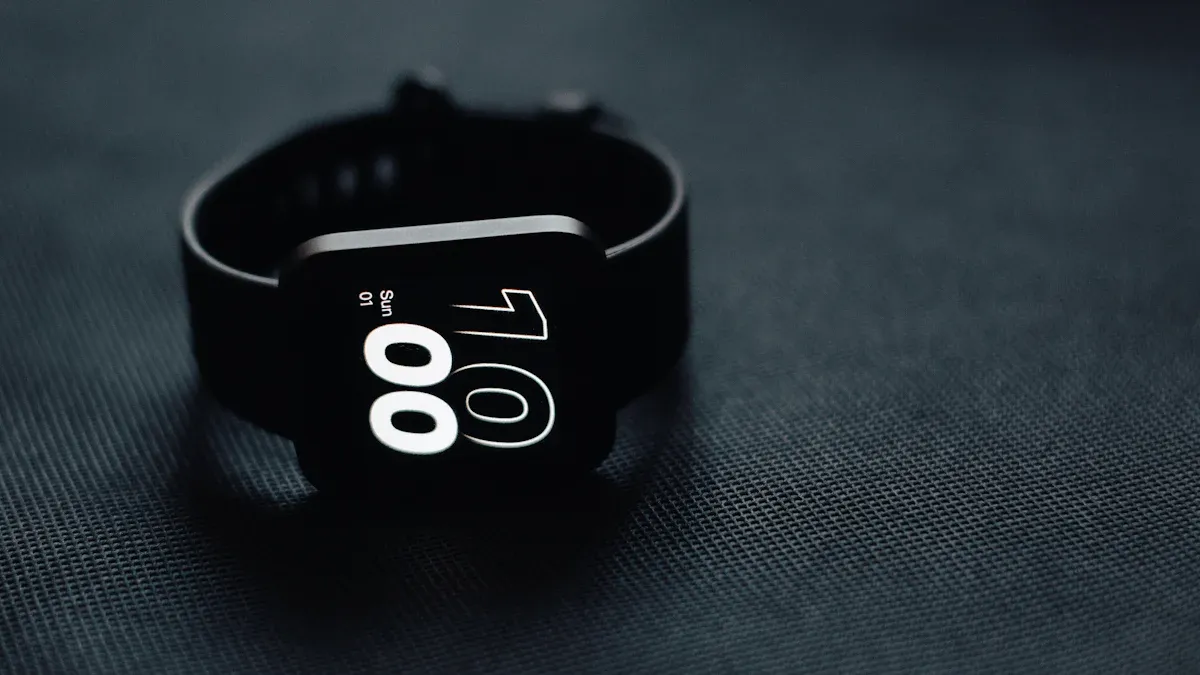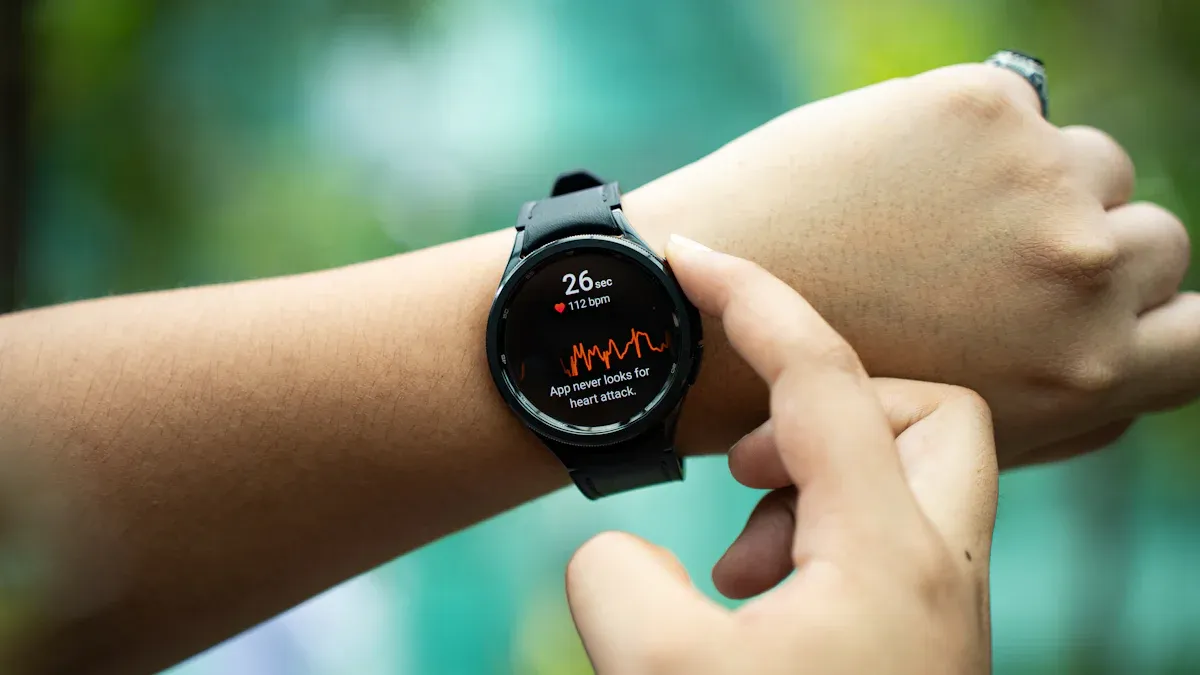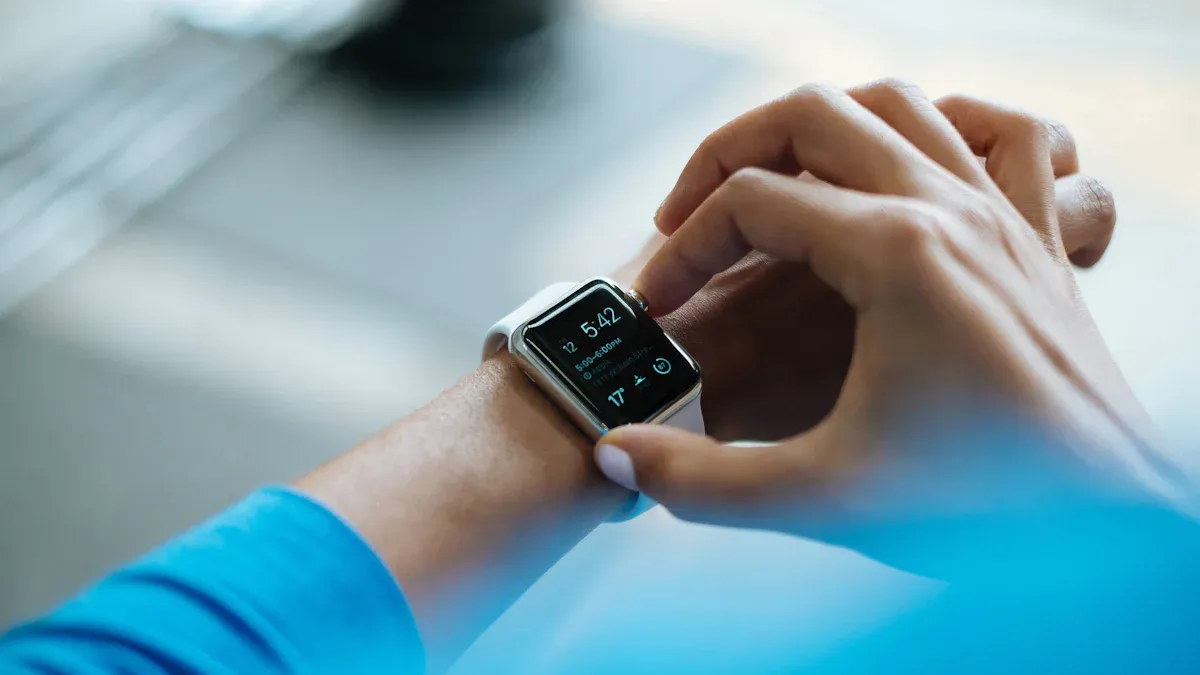Building a Smart Bracelet for ECG and Health Monitoring with AD8233ACBZ-R7

The AD8233ACBZ-R7 plays a crucial role in advancing health monitoring equipment. Integrating the AD8233ACBZ-R7 into a smart bracelet enhances its functionality by providing precise ECG readings and enabling real-time health checks. This innovation is central to the AD8233ACBZ-R7 smart bracelet remote medical terminal design, which is transforming wearable health devices into essential tools for modern healthcare. These devices are far more convenient and user-friendly compared to traditional methods.
Wearable health monitoring equipment is increasingly popular in both clinical settings and home environments. Medical wearables, such as glucose monitors, are invaluable for post-surgery care and managing chronic illnesses. Meanwhile, consumer devices like smartwatches offer affordable and easy-to-use solutions. Approximately 20% of doctors now recommend wearable technology for health tracking, underscoring its growing importance. The AD8233ACBZ-R7 smart bracelet exemplifies this progress in remote medical terminal design.
Wearable health technology simplifies personal health monitoring while fostering better data sharing between doctors and patients. This evolution highlights how devices like the AD8233ACBZ-R7 smart bracelet are revolutionizing health monitoring equipment and improving healthcare outcomes.
Key Takeaways
The AD8233ACBZ-R7 improves smart bracelets by giving clear ECG results.
Health devices like smart bracelets check health all day and send alerts fast.
The AD8233ACBZ-R7 uses little power and is tiny, so batteries last longer and bracelets stay comfy.
Good signal processing gives clear ECG data to watch heart health and spot problems early.
Smart bracelets are easy to use for all ages, helping people track health and build good habits.
Features of the AD8233ACBZ-R7
Low Power Use
The AD8233ACBZ-R7 uses very little power. This makes it perfect for smart bracelets and other wearables. It helps the battery last longer, so you don’t need to charge often. The low power design also keeps the bracelet light and easy to carry. Smaller batteries can be used without losing performance. This is important for all-day ECG monitoring.
Small Size
The AD8233ACBZ-R7 is very small in size. Its tiny design fits well in wearable devices like bracelets. Space is limited in these devices, so this is helpful. Even though it’s small, it works very well. You can make stylish and comfy designs without losing features. Its small size also makes the device lighter, which users will like.
Boosts ECG Signals
The AD8233ACBZ-R7 makes heart signals stronger. It captures and boosts heart signals with great accuracy. This means you get clear and correct ECG readings. It also reduces noise and errors for better results. Whether for personal or medical use, this amplifier gives top-quality ECG signal boosting.
Designing a Smart Bracelet

Hardware Integration
Making a smart bracelet starts with connecting the hardware. All parts, like the AD8233ACBZ-R7, sensors, battery, and microcontroller, must work well together. Planning is key to keep the bracelet small and useful. A smaller design makes it light and comfy for daily use.
Testing the hardware is important. Tools like CurveBoards help check circuits while keeping the bracelet's shape. These 3D-printed boards let you test how the electronics work and feel in real life. This helps make sure the bracelet works well and feels good to wear.
Evidence Description | Why It Matters for Smart Bracelets |
|---|---|
CurveBoards are 3D-printed boards that test circuits in physical designs. | Helps test bracelet designs early for both looks and function. |
CurveBoards keep the design's look while testing how it works. | Important for bracelets to check real-world use and comfort. |
Testing electronics on prototypes speeds up checking circuits and user experience. | Makes sure the bracelet works and feels right faster. |
Using these tools saves time and helps move from testing to making the final product quickly.
Signal Processing
Signal processing helps understand heart data from the AD8233ACBZ-R7. It boosts and cleans heart signals, but the data must be clear and correct. Special programs remove noise to give accurate ECG readings for health checks.
Studies show wearable devices can read heart data well. For example, KardiaPro found 100% sensitivity and 96% specificity for spotting heart problems. This shows how good signal processing is for wearable health devices.
Study/Source | Sensitivity | Specificity | Results |
|---|---|---|---|
KardiaPro (US Approval) | 100% | 96% | Found heart issues like AF accurately. |
Australian Study | 95% | 99% | Found new AF cases in 0.8% of patients. |
SEARCH-AF Study | N/A | N/A | Found new AF in 1.5% of patients, total rate 6.7%. |
Good signal processing makes sure the bracelet gives clear health info, making it helpful for users.
Power Optimization
Saving power is important for smart bracelets to last longer. Small batteries need smart power use so users don’t charge often. The AD8233ACBZ-R7 uses little power, making it a great choice.
Different ways to save power have pros and cons. The SmartAPM system changes power use based on user habits. Machine learning can also help by studying how people use the device. Simple methods work but may not adjust to real-time needs.
Approach | Benefits | Downsides |
|---|---|---|
Simple Methods | Easy to use | Can’t change based on user habits. |
SmartAPM System | Adjusts power in real-time | Needs setup for each user. |
Rule-based Systems | Easy to set up | Doesn’t adapt to changes. |
Machine Learning | Learns from user data | Often focuses on one part only. |
Mixing these methods can balance power saving and performance, keeping the bracelet useful and easy to wear.
Ergonomic Design
Making a smart bracelet requires a comfy and user-friendly design. The bracelet should feel good on your wrist all day. A comfortable design makes people want to wear it often. This is important for tracking health regularly.
Different groups of people like different designs. Older adults like simple and easy-to-use devices. Younger people enjoy bracelets they can personalize. Professionals prefer stylish and elegant designs. By thinking about these needs, you can make a bracelet everyone likes. It will look good, feel good, and work well for all users.
Testing designs with real users shows why comfort matters. Research by Lacko et al. (2017) found flexible bands and smart sensor placement help a lot. These features make bracelets more comfortable and easier to use. The table below shows key findings from the research:
Evidence Type | Description |
|---|---|
Ergonomic Design Importance | User tests showed better comfort and usability in wearables. |
Key Design Features | Flexible bands and good sensor spots reduced discomfort. |
Outcome | Better comfort gave accurate readings and happier users. |
To make a great bracelet, use light materials and adjustable straps. These features help the bracelet fit well without causing irritation. Placing sensors in the right spots also improves data accuracy. Focusing on comfort makes the bracelet easy to wear every day. This helps users make it a regular part of their lives.
Applications in Health Monitoring

Heart Rate and ECG Monitoring
Smart bracelets are great for checking your heart's health. They can track your heart rate and ECG all day and night. This helps you see any heart problems right away. The AD8233ACBZ-R7 chip makes these readings clear and correct, so you can trust the data.
In studies, experts use different ways to check how accurate these devices are. Here's a table showing some of these methods:
Statistical Method | What It Does |
|---|---|
Intention-to-treat analysis | Looks at data as planned, even if some is missing. |
Time-series data | Groups heart rate and steps into 1-minute chunks. |
Summary statistics | Shows results as numbers, percentages, or averages. |
Kruskal–Wallis test | Checks differences between groups without needing normal data. |
t-test | Compares groups if the data is normal. |
Spearman’s test | Measures how two things are connected. |
Generalized linear models | Tracks heart rate changes over time. |
Post-hoc subgroup analysis | Studies activity levels based on health guidelines. |
Statistical software | Uses tools like Stata v.17 to find important results (P < 0.05). |
These methods make sure the data from your bracelet is useful for doctors and nurses.
Remote Medical Terminal Design
Smart bracelets help doctors check your health from far away. They send your health data to your doctor in real-time. These bracelets have parts for video, sound, and health tracking. This makes sure your health info is sent correctly.
The bracelet has two main parts: one for video and sound, and another for health data.
Tests showed the bracelet sends data to the server without mistakes.
Results from tests matched what the software was designed to do, proving it works well.
Communication tests showed the bracelet can send data to the service center quickly.
These features make it easier for doctors to help you without needing a clinic visit.
Benefits Over Traditional Methods
Smart bracelets are better than old ECG methods in many ways. They are easier to use and give more helpful information. Here's a comparison:
Benefit | Smart Bracelets | Traditional ECG Methods |
|---|---|---|
Continuous Monitoring | Tracks health all the time | Only during doctor visits |
Convenience | Easy to use anywhere | Needs special equipment |
Real-time Alerts | Warns you right away | Delayed results |
Data Accuracy | Reduces mistakes | Needs manual input |
Trend Analysis | Shows long-term health patterns | Limited tracking |
Motivation | Encourages healthy habits | No extra motivation |
Integration | Shares data with doctors easily | Hard to share data |
Customization | Gives personal health tips | General advice only |
Multifunctionality | Tracks more than just ECG | Focuses only on ECG |
Accessibility | Works for more people | Harder to access |
Smart bracelets make health tracking simple and part of your daily routine. They help you stay aware of your health and take action early. Unlike old methods, they show daily changes and give a full picture of your health.
Overcoming Design Challenges
Fixing Signal Problems
Getting clear ECG signals is very important. Wearable devices can pick up unwanted signals from outside sources like electric fields or movement. To fix this, use special filters to clean the ECG signals. Covering the device parts can also block outside interference.
Putting sensors in the right spots on the bracelet helps avoid problems from movement. Using soft materials and snug straps keeps sensors steady on the skin. These steps make heart monitoring better and give accurate health data.
Managing Battery Life
Smart bracelets need to work well and have long battery life. The AD8233ACBZ-R7 uses little power, which helps the battery last longer. Testing the battery in different situations makes sure it’s safe and works well.
Test Type | Why It’s Important for Battery Life |
|---|---|
Electrical safety | Checks if the battery works safely in the bracelet. |
Battery safety | Tests how long the battery lasts and stays safe. |
Electromagnetic compatibility (EMC) | Makes sure electric fields don’t harm the battery. |
Usability | Ensures the battery is easy for users to manage. |
Power-saving modes can help save energy by changing how the bracelet works based on what the user is doing. Machine learning can study how people use the bracelet and adjust energy use. These ideas help the bracelet work all day without needing to charge often.
Keeping Data Correct
Good health tracking needs accurate data. The AD8233ACBZ-R7 improves ECG signals by making them stronger and clearer. But testing is needed to make sure the device works well.
Checking data with math tools finds mistakes and keeps it consistent.
Methods like regression and chi-square tests ensure the data is high quality.
Validation proves the device is accurate enough for medical use.
Testing confirms the bracelet meets health standards.
Strong hardware and careful testing make sure the bracelet gives clear and useful health information.
Future Trends in Wearable Medical Devices
AI Integration
AI is making wearables smarter for health tracking. It can study ECG data and find health risks early. Smart programs spot heart patterns and give helpful tips. For example, AI can warn about irregular heartbeats before they get worse.
Wearables now use voice commands too. You can talk to your device and get answers fast. Imagine asking your bracelet about your heart rate and hearing the result right away. AI follows P4 medicine ideas—predictive, preventive, personalized, and participatory—to improve healthcare.
Advancement Type | What It Does |
|---|---|
Predictive Analytics | Finds health risks and gives advice. |
Personalized Health Interventions | Adjusts tips based on your health data. |
Voice Recognition | Lets you talk to your device for quick help. |
IoT Connectivity
The Internet of Things (IoT) helps wearables connect with other devices. IoT lets your bracelet share health data with phones or doctors instantly. This makes health checks faster and easier.
For example, fitness tools like STEPR use Wi-Fi for live updates. SportPlus uses Bluetooth to track workouts better. These features make wearables more useful for daily health needs.
Case Study | Feature Used | How It Helps | Result |
|---|---|---|---|
STEPR | Wi-Fi | Turns fitness tools into smart devices with live updates. | Adds updates and fun options, improving user experience. |
SportPlus | Bluetooth (BLE) | Uses Bluetooth to manage workouts. | Gives smarter, data-based workout plans for fitness goals. |
Cloud-Based Health Monitoring
Cloud technology changes how wearables handle health data. It stores and studies your data online for quick insights. Doctors can check your heart info remotely and act fast.
The COVID-19 pandemic sped up cloud use in health tech. Now, wearables use it for health records and better diagnoses. This helps telemedicine and remote care become easier and faster.
Cloud tech sends medical data safely for instant checks.
It supports health records and personal health advice.
The pandemic showed its value, boosting wearable tech growth.
These trends make wearables key tools for modern healthcare. They help you stay healthy and connected to your doctor.
The AD8233ACBZ-R7 has changed wearable health technology. Its small size, low power use, and strong ECG signal boosting allow real-time heart checks and personal health tips. These features make it a budget-friendly choice for wearables, helping more people access better healthcare.
The device captures clear ECG signals to spot heart problems early. It also helps with long-term care for ongoing health issues. Remote monitoring is easier, making healthcare better for both patients and doctors.
Smart bracelets using the AD8233ACBZ-R7 show how flexible it is. Its small size and low power needs let makers design light and stylish devices. Built-in filters make creating these devices simpler. They can track heart health, improve workouts, and help manage chronic illnesses.
Using the AD8233ACBZ-R7, you can help improve health tech. It lets you build devices that help people take charge of their health.
FAQ
Why is the AD8233ACBZ-R7 good for wearables?
The AD8233ACBZ-R7 is small and saves energy. Its tiny size fits well in bracelets and other wearables. It also makes heart signals stronger and more accurate. These features help create light and easy-to-use devices.
How does the AD8233ACBZ-R7 make ECG signals better?
The AD8233ACBZ-R7 removes noise and unwanted signals. It boosts weak heart signals to give clear ECG readings. This helps you check your heart health at home or for medical needs.
Can smart bracelets replace regular ECG machines?
Smart bracelets track your heart all the time and send alerts fast. They are easy to carry and use daily. But for detailed tests, regular ECG machines are still needed.
How long does a smart bracelet battery last with the AD8233ACBZ-R7?
The AD8233ACBZ-R7 uses very little power, saving battery life. Depending on how you use it, the bracelet can last days without charging. Power-saving features make the battery last even longer.
Are smart bracelets good for all ages?
Yes, people of all ages can use smart bracelets. Older people like the simple health tracking. Younger users enjoy the cool designs and fitness tools. These bracelets mix style and health features for everyone.
See Also
Unveiling the ADXL357BEZ: An Efficient Accelerometer Solution
Uncovering the AD7656BSTZ: ADI's 16-Bit ADC Wonder
Introducing the ADXRS453BRGZ: A Precision Motion Sensor
Utilizing the ATmega328P-AU for Your DIY Projects
Embedded Systems and XC2C128-7VQG100I: Programmable Logic Devices

